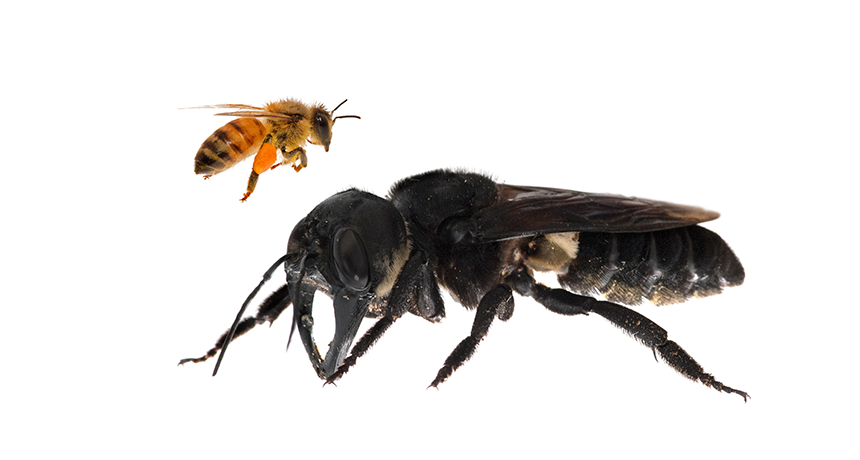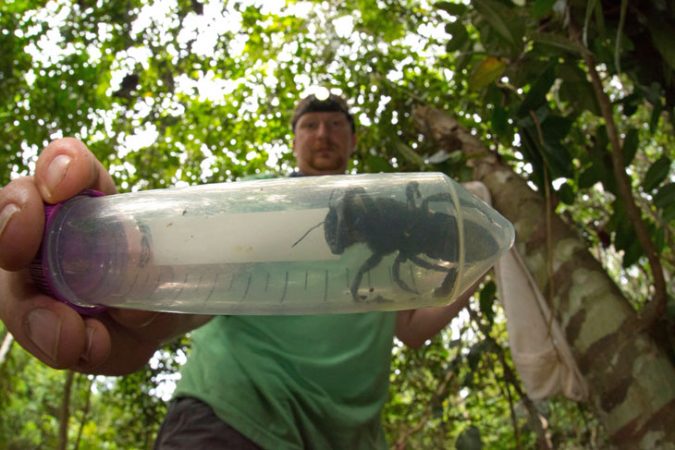The world’s largest bee was lost, but now it’s found
Scientists are abuzz over rediscovery of Wallace’s giant bee, missing for almost 40 years

When they call it “Wallace’s giant bee,” they aren’t kidding about the giant part. This bee’s body is as big as a walnut, and its wingspan is almost as big as a credit card!
C. Bolt
By Jeremy Rehm
Everything about Wallace’s giant bee is, er, giant. The bee’s body is around 4 centimeters (1.6 inches) long — about the size of a walnut. Its wings spread to more than 7.5 centimeters. (2.9 inches) — almost as wide as a credit card. A bee that big would be hard to miss. But it’s been nearly 40 years since the world’s largest bee (Megachile pluto) was spotted in the wild. Now, after two straight weeks of searching, scientists have found the bee again, still buzzing through the forests of Indonesia.
Eli Wyman wanted to go on a bee hunt. He’s an entomologist — someone who studies insects — at Princeton University in New Jersey. He and a colleague made the hunt as part of a project led by Global Wildlife Conservation. That’s an organization in Austin, Texas, that tries to help species that are about to die out forever.
Global Wildlife Conservation gave scientists money for expeditions to find 25 species that were feared to be gone forever. But first the organization had to choose which 25 species would be hunted. Scientists from around the world suggested more than 1,200 possible species. Wyman and photographer Clay Bolt nominated Wallace’s giant bee. Despite the competition, the bee won out as one of the top 25.
Into the jungle
Wyman, Bolt and two other scientists set off to Indonesia on a bee hunt in January 2019 for a two-week excursion. They headed to forests on two of only three islands where the bee had ever been found.
Female Wallace’s giant bees call termite nests home. The bees use their formidable jaws to burrow into the nests. Then the insects line their tunnels with resin to ward off their termite landlords. To find the giant bee, Wyman and his team hiked through the oppressive jungle heat and stopped at every termite nest they saw on the trunk of a tree. At each stop, the scientists halted for 20 minutes, searching for a telltale bee hole or for one of the insects to emerge.
For several days, all the termite nests came up empty. The scientists began to lose hope. “I think we all kind of internally just accepted that we weren’t going to be successful,” Wyman says.
But as the search was ending, the team decided to check one last nest only about 2.4 meters (7.8 feet) off the ground. There, they found a signature hole. Wyman, standing on a small platform, glanced inside. He gently tapped inside the hole with a stiff blade of grass. That must have been annoying. Moments later, a lone female Wallace’s giant bee crawled out. Wyman says that his grass blade probably bonked the bee on the head.

“We were just all over the moon,” Wyman says. “It was a great relief and incredibly exciting.”
The team captured the female and put her inside a tented enclosure. There, they could observe her before releasing her back to her nest. “She was the most precious thing on the planet to us,” Wyman says. She buzzed and opened and closed her enormous jaws. And yes, she has a stinger to match her goliath size. She could probably use it, but Wyman wasn’t willing to find out firsthand.
Global Wildlife Conservation announced the bee’s rediscovery on February 21. There are no set plans to go back and look for more bees. Scientists know very little about the species. But they do know that some locals have stumbled on the bee in the past. They even made money off the insects by selling them online.
The team hopes the rediscovery sparks efforts to protect the bee and the Indonesian forests where it lives. “Just knowing that this bee’s giant wings go thrumming through this ancient Indonesian forest helps me feel that, in a world of so much loss, hope and wonder still do exist,” Bolt wrote online.
Science News/YouTube







